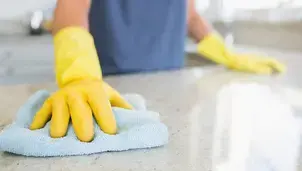Why can damp and mould trigger asthma?
Living somewhere that is damp or mouldy is not good for your asthma. Babies, small children, older people, people with asthma, and people with allergies are more likely to be affected by damp and mould.
Mould is a type of fungus that grows in damp places. If you’ve got mould where you live, you’ll notice fuzzy black, white, or green patches on the walls, ceilings, or tiles.
Mould produces spores which can be breathed in. If you’re allergic to mould spores you might have symptoms like coughing, wheezing or sneezing. It could also trigger your asthma symptoms.
Damp and mould can increase your risk of other things that could make your asthma worse, like chest infections, colds and flu, and rhinitis (when your nose is irritated).
"If you’re having asthma symptoms or need your reliever inhaler three or more times a week, see your GP or asthma nurse. Whether it’s damp, mould, or something else making your asthma worse, they can help you get back in control of your symptoms." – Dr Andy Whittamore, Asthma + Lung UK’s in-house GP.
How to manage damp and mould
- Always keep your reliever inhaler with you, so you can use it for quick relief when you get symptoms.
- Use a written asthma action plan, so that you know exactly what to do if your symptoms start.
- Manage your asthma well. If you have a preventer inhaler or a MART inhaler, take it every day as prescribed, even if you feel well.
- Speak to your GP or asthma nurse about antihistamines and nasal sprays to help you manage allergy symptoms.
- Shelter or Citizens Advice can give you advice and support about housing, especially if you live in a rented home.
How can I manage damp and mould where I live?
If you think your home is damp, it’s important to act quickly to find out what’s causing the damp and deal with mould.
Take a look at how to prevent condensation in your home.
Read more

Get support
Call our Helpline for support with your condition. Get advice on your medicines, symptoms or travelling with a lung condition, or just call us to say hello.







